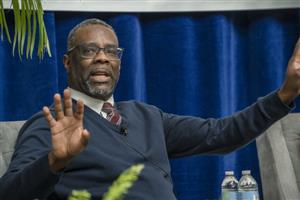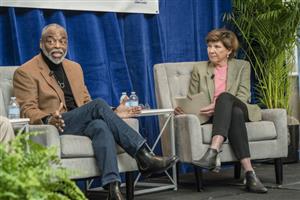- Council of the Great City Schools
- Fighting for Student Reading Success
Urban Educator - April 2023
Page Navigation
- Education Secretary Cardona: School Leaders, Be Changemakers
- Fighting for Student Reading Success
- Journalist Says Urban School Leaders in the Forefront of Change
- Kansas City Names New Superintendent
- How Three Urban School Districts are Investing and Tracking ESSER Funds
- Linguist Lily Wong Fillmore Named Recipient of Dr. Michael Casserly Legacy Award
- Urban Schools Win Green Ribbon Awards
Fighting for Student Reading Success
-
Kareem Weaver is second vice president of the NAACP in Oakland and chair of its education committee, and in the past held posts as a teacher, principal, and administrator.
Weaver holds another, albeit unofficial, title: literacy warrior.
The educator is fighting to help students learn how to read. He is a cofounder and executive director of Full and Complete Reading Is a Universal Mandate, which partners with stakeholders to improve reading results for students.
Weaver’s efforts are chronicled in a new documentary, The Right to Read, which examines his quest to improve literacy rates using evidence-based literacy tools and explicit and direct reading instruction.
Weaver joined the film’s director, Jenny Mackenzie, and the film’s executive producer, LeVar Burton, in a discussion at the Council of the Great City Schools’ Legislative/Policy Conference. (Watch the entire discussion)
For Weaver, literacy is a civil rights issue, an extension of protests fighting racism and segregation in the 1960s. “Our kids can sit at the lunch counter today, but they can’t read the menu,” Weaver said. “The right to read is really the right to engage in society.”

He asked conferees to try turning off their ability to read for a day. “I’ve led groups in doing it and most people last about 10 minutes,” said Weaver. “We don’t think about how core it is in everything we do.”
Burton, actor, director, and longtime host of the educational television series Reading Rainbow, said he believes it is difficult if not impossible to reach one’s full potential if you can't read. “You may be successful--maybe even beyond your wildest imaginings successful,” stressed Burton. “But you will not have reached your full potential in life.”
According to National Assessment of Educational Progress (NAEP) data, 37 percent of U.S. 4th graders read “below basic” while 56 percent of Black 4th graders, 50 percent of Hispanic 4th graders, and 57 percent of American Indian/Alaska Native 4th graders have “below basic” reading skills.
Burton characterized these statistics as “criminal in this day and age.” He was blunt: “A third of our kids can't read. This is frightening.” The nation cannot fix the problem of students not reading in a single generation, he acknowledged, but can decide that the lack of literacy is a priority and muster the will to tackle the issue.
The Science of Reading
The documentary focuses on two approaches to reading instruction: “balanced literacy,” with less emphasis on phonics in favor of providing books to students and promoting a love of reading, whereas “the science of reading” emphasizes a phonics-based system of reading instruction teaching students the relationship between sounds and letters.
Weaver, himself a former administrator, called on district leadership--from superintendents to school board members—to take the lead in implementing the science of reading in literacy instruction.
“This is something we can actually put hands on and make a difference,” he said. “But the question is, what things can we put in place as staff or board members to actually make a difference? We have to provide [teachers] with the training and curriculum on research-based evidence in literacy. That just has to happen.”
Participating in a Democracy
Mackenzie, who moderated the discussion, asked Burton to explain exactly what it means for people in an information age not to be able to access information because they are unable to read.

“In terms of being a participating citizen in this democracy, if you do not have a facility of literacy, then you are left out,” said Burton. “If you can't read, you can't digest the ballot. You don't know what the measures, the initiatives, the propositions are about. You cannot participate in the democracy if you can't read.”He told conferees their role is vital. “We need to equip the next generation [of educators] to be able to be [literacy] soldiers, warriors in their own right,” said Burton. “Failing to do that fails our kids.”
Teaching students to read should not be a partisan issue but rather a matter of common sense, he said.
“I actually want your child to learn to read, even if your child doesn't look like mine, especially if you are my neighbor,” said Weaver. “… Because when our kids can read, they act differently. They walk and feel differently, and they have a different relationship to the community and to the people around them.”
Reading is a civil rights issue
Media Contact:
Contact Name
Contact@email.com
(000) 000-0000
Contact Name
Contact@email.com
(000) 000-0000
Contact Name
Contact@email.com
(000) 000-0000
Media Contact:
Contact Name
Contact@email.com
(000) 000-0000
Contact Name
Contact@email.com
(000) 000-0000
Contact Name
Contact@email.com
(000) 000-0000


